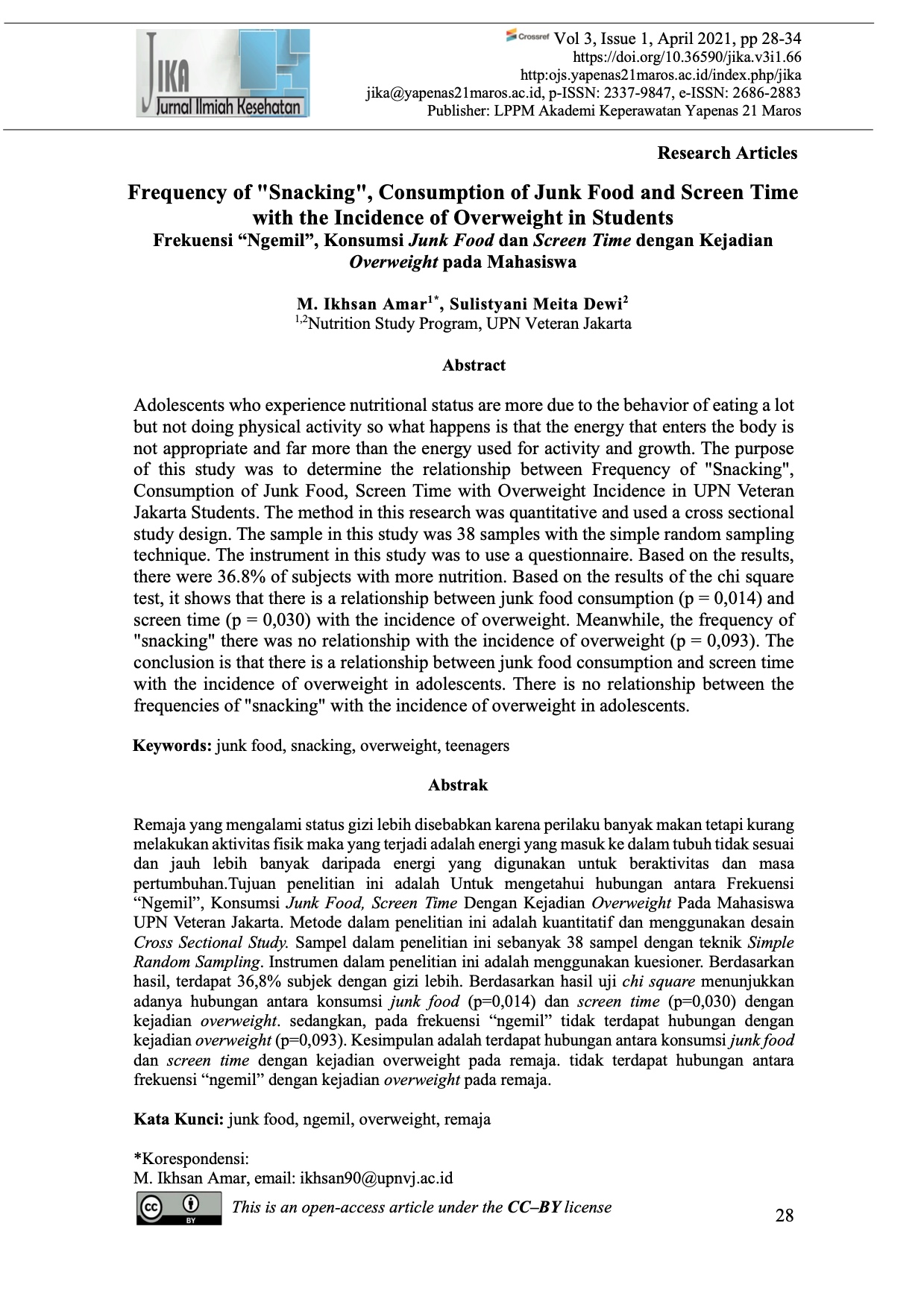Frequency of "Snacking", Consumption of Junk Food and Screen Time with the Incidence of Overweight in Students
DOI:
https://doi.org/10.36590/jika.v3i1.66Keywords:
junk food, snacking, overweight, teenagersAbstract
Adolescents who experience nutritional status are more due to the behavior of eating a lot but not doing physical activity so what happens is that the energy that enters the body is not appropriate and far more than the energy used for activity and growth. The purpose of this study was to determine the relationship between Frequency of "Snacking", Consumption of Junk Food, Screen Time with Overweight Incidence in UPN Veteran Jakarta Students. The method in this research was quantitative and used a cross sectional study design. The sample in this study was 38 samples with the simple random sampling technique. The instrument in this study was to use a questionnaire. Based on the results, there were 36.8% of subjects with more nutrition. Based on the results of the chi square test, it shows that there is a relationship between junk food consumption (p = 0,014) and screen time (p = 0,030) with the incidence of overweight. Meanwhile, the frequency of "snacking" there was no relationship with the incidence of overweight (p = 0,093). The conclusion is that there is a relationship between junk food consumption and screen time with the incidence of overweight in adolescents. There is no relationship between the frequencies of "snacking" with the incidence of overweight in adolescents.
Downloads
References
Amalia, RN, Sulastri, D., Semiarty, R., 2016. The Relationship between Junk Food Consumption and Over Nutritional Status in Students of SD Pertiwi 2 Padang. Andalas Health Journal 5, 185–190.
Amalia, R.N., Sulastri, D., Semiarty, R., 2016. Hubungan Konsumsi Junk Food dengan Status Gizi Lebih pada Siswa SD Pertiwi 2 Padang. Jurnal Kesehatan Andalas 5, 185–190.
Ariyana, D., Asthiningsih, N.W.W., 2020. Hubungan Pengetahuan dengan Kebiasaan Konsumsi Makanan Cepat Saji (Fast Food) pada Siswa-Siswi Kelas XI di SMA Negeri Samarinda. Borneo Student Research 1, 1841–1846.
Ayuni, G.D., 2017. Hubungan Sedentary Time, Kebiasaan Snacking, dan Aktivitas Fisik Dengan Status Gizi serta Komposisi Lemak Tubuh Siswa di SDN Karang Pawulang Kota Bandung.
Hanum, T.S.L., Dewi, A.P., Erwin, 2015. Hubungan Antara Pengetahuan dan Kebiasaan Mengkonsumsi Fast Food Dengan Status Gizi Pada Remaja. c Jurnal Online Mahasiswa Program Studi Ilmu Keperawatan Universitas Riau 751–758.
Health Office of West Java Province, 2017. Profil Kesehatan Dinas Kesehatan Provinsi Jawa Barat 2017. Dinas Kesehatan Provinsi Jawa Barat.
Indonesian Ministry of Health, 2013. Riset Kesehatan Dasar 2013. Kemenkes RI, Jakarta.
Indonesian Ministry of Health, 2018. Hasil Utama Riskesdas 2018. Kemenkes RI.
Izhar, M.D., 2020. Hubungan Antara Konsumsi Junk Food, Aktivitas Fisik dengan Status Gizi Siswa SMA Negeri 1 Jambi. Jurnal Formil (Forum Ilmiah) KesMas Respati 5, 1–7.
Lestari, E.I., Asthiningsih, N.W.W., 2020. Hubungan Pola Makan dengan Kebiasaan Konsumsi Makanan Cepat Saji (Fast Food) pada Siswa-Siswi Kelas XI di SMA Negeri Samarinda. Borneo Student Research 1, 1766–1771.
Maiyuni, C., 2018. Perbedaan Aktivitas Fisik dan Kebiasaan Sarapan Antara Siswa Overweight dan Non-Overweight di SMPN 3 Surakarta. [SKRIPSI]. Universitas Muhammadiyah Surakarta.
Mhaske, S., Patel, P., 2013. Bye Bye Junk Food. International Jornal of Food, Nutrition, and Dietetics 1, 55–56.
Ningrum, D.M.A., 2018. Hubungan Screen Time Dengan Indeks Massa Tubuh Pada Mahasiswa Fakultas Ekonomi Dan Bisnis Universitas Muhammadiyah Surakarta. [Artikel]. Universitas Muhammadiyah Surakarta.
Nurhayati, A., Lasmanawati, E., 2012. Pengaruh Mata Kuliah Berbasis Gizi Pada Pemilihan Makanan Jajanan Mahasiswa Program Studi Pendidikan Tata Boga. Jurnal Penelitian Pendidikan 13, 1–6.
Oktaviani, W.D., Saraswati, L.D., Rahfiludin, M.Z., 2012. Hubungan Kebiasaan Konsumsi Fast Food, Aktivitas Fisik, Pola Konsumsi, Karakteristik Remaja Dan Orang Tua Dengan Indeks Massa Tubuh (IMT) (Studi Kasus pada Siswa SMA Negeri 9 Semarang Tahun 2012). Jurnal Kesehatan Masyarakat 1, 542–553.
Paramitha, A.I., Tt, A.A., Handoko, W., 2013. Association of Children’s Dietary Pattern, Physical Activity, And Parent’s Economic Status With Childhood Obesity In South Pontianak Elementary Schools. Jurnal Mahasiswa PSPD FK Universitas Tanjungpura 3, 1–15.
Pramudita, S.R., Nadhiroh, S.R., 2018. Gambaran Aktivitas Sedentari Dan Tingkat Kecukupan Gizi Pada Remaja Gizi Lebih dan Gizi Normal. MGI 12, 1–6. https://doi.org/10.20473/mgi.v12i1.1-6
Putro, K.Z., 2018. Memahami Ciri dan Tugas Perkembangan Masa Remaja. aplikasia 17, 25. https://doi.org/10.14421/aplikasia.v17i1.1362
Septiana, P., Nugroho, F.A., Wilujeng, C.S., 2018. Konsumsi Junk food dan Serat pada Remaja Putri Overweight dan Obesitas yang Indekos. JKB 30, 61–67. https://doi.org/10.21776/ub.jkb.2018.030.01.11
Suharsa, H., Sahnaz, 2016. Status Gizi Lebih dan Faktor-faktor lain yang Berhubungan pada Siswa Sekolah Dasar Islam Tirtayasa Kelas IV dan V di Kota Serang Tahun 2014. Jurnal Lingkar Widyaiswara 3, 53–76.
Utami, N.P., Purba, M.B., Huriyati, E., 2018. Exposure of Screen Time in Relationship with Obesity in Junior High School Adolescence in Yogyakarta. J. Dunia Gizi 1, 71–78. https://doi.org/10.33085/jdg.v1i2.3419
Wicaksono, E.Y., 2015. Hubungan Antara Frekuensi “Ngemil”, Durasi Menonton Tv Dan Durasi Bermain Games Dengan Kejadian Overweight Pada Remaja di SMP Negeri 5 Karanganyar. [Artikel]. Universitas Muhammadiyah Surakarta.
Wulandari, S., Lestari, H., Fachlevy, A.F., 2016. Faktor Yang Berhubungan Dengan Kejadian Obesitas Pada Remaja di SMA Negeri 4 Kendari Tahun 2016. JIM Kesmas 1, 1–13.









